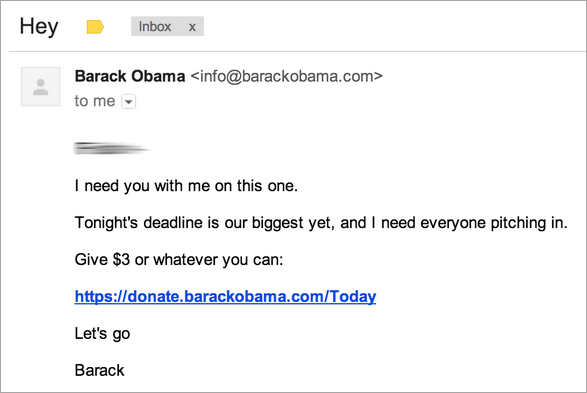8 simple ways to write a killer subject line
Average reading time: 2.5 minutes
Today’s subject? Subject line optimization.
Your subject line is your email’s first impression—and it’s a hard one to make.
On average, people receive emails from about 11 brands a day, meaning you have to find a way to make your promotional email the one they can’t resist clicking on to discover more.
The good news?
Email marketing works. 76% of email list subscribers claim to make purchases from email promotions.
To help increase your open rates, click-through rates, and ultimately, conversion rates, we’ve put together a list of 8 simple things to consider the next time you’re crafting a subject line.
1. Include the recipient’s first name. Companies that use this easy personalization technique see a 29% increase in open rates. Note the difference in intimacy: “An article you might like” or “An article you might like, Lauren”.
“Remember that a person’s name is to that person the sweetest and most important sound in any language.” —Dale Carnegie
Caution: it’s important to mix it up. Including the recipient’s first name in every subject line can get old and your subscribers will catch on. To spice things up, try including their company name, social media handle, birthday, or location.
For those of you using Hubspot for your email marketing efforts, check out this resource on how to insert personalization tokens.
2. Make your content relevant by connecting your subject line to current events. Neil Patel colourfully explains:
Let’s say you have an ecommerce company that sells clothing. You’ve got your email subscribers segmented by location based on their zip codes. It’s February, and a winter snowstorm is approaching the states in New England. You could send an email with a breaking news subject line about the storm and say that you’re selling winter coats, hats, and gloves at a discounted rate.
What about something like “Today only: 10% off all coats for snowstorm” or “Breaking: snowstorm coming & we’ve got the gear”?
Pro tip: If you’re struggling to find current events that connect to your email of the day, try thinking of some cool and exciting things happening within your organization—like a new product release or a new team member.
4. Avoid “spammy” words and symbols that get red flagged in spam filters or by subscribers. Did you know that 69% of recipients report emails as spam based solely on the subject line?
CoSchedule put together a great list of words to avoid. You’ll see that exclamation marks are at the top of the list!
Also, while we’re on the topic of annoying people, AVOID ALL CAPS. Research shows that 85% of people would prefer an all-lowercase subject line to an all-caps subject line.
Be sure to read MailChimp’s rundown on how to avoid spam filters for a more detailed understanding of spam laws, email firewalls, and best practices.
Also, while we’re on the topic of annoying people, avoid ALL CAPS. Research shows that 85% of people would prefer an all-lowercase subject line to an all-caps subject line.
5. When it comes to frequency, just chill. The number one reason why recipients report emails as spam is because they feel that they’re being contacted too much.
6. Give some of these words a shot (as they tend to lead to killer open rates):
- For time-sensitivity: today, only, now, urgent, important, breaking, just
- “Only 4 spots left”
- For simplicity: easy, cheat-sheet, on-demand, guide
- “How to calm your anxiety in 3 easy steps”
7. Make it mobile-friendly because the majority of your email recipients are opening their emails on smartphones or tablets.
Need more justification? Your subscribers are impatient. 70% of consumers claim to immediately delete emails that don’t render well on mobile.
7. Keep it short. Research shows that the best performing subject lines are between 1 and 20 characters in length.
With that being said, some research shows that the length “doesn’t really seem to make much of a difference” when you’re between 10 and 50 characters.
MailChimp’s advice? Just stick to less than 50 characters.
8. Include numbers when you can. In the words of Hubspot:
“A lot of businesses send emails with vague statements in their subject lines—which is why using data and numbers is a great way to get your emails noticed, demonstrate a clear and straightforward message about your offer, and set the right expectations.”
TL; DR? There’s a difference between “Join us at this event” and “Join us and 750 others at this event”.
Conclusion
More than 50% of companies generate 10% of sales from sending emails alone, so playing around with your subject lines and their efficacy is a worthwhile investment.
Keep in mind that creating a great subject line is both an art and a science. If you’re trying new things, A/B testing, and tracking results, you’re one step ahead (remember, you’re not shooting for a 100% open rate; the average is around 20%).
Keep in mind that creating a great subject line is both an art and a science. If you’re trying new things, A/B testing, and tracking results, you’re one step ahead.
Take a look at the Obama campaign’s top email subject lines and see the importance of experimentation for yourself.
I mean, one of their most successful subject lines was a simple “Hey”.
Email marketing is just one piece of the digital marketing puzzle. RTOWN specializes in helping local businesses with their social media, SEO, and website design. Let’s have a quick chat about your business’ current online presence.
Don’t forget to share this post!







